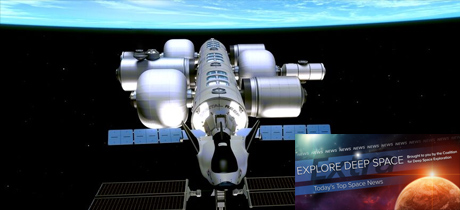In Today’s Deep Space Extra… International Space Station resuming normal operations after debris threat. Pockets of frozen CO2 on the Moon could aid space travel. See photos of the Beaver Moon lunar eclipse.
Human Space Exploration
Station resumes normal operations, but risk from Russian ASAT test continues
Coalition Member in the News – Northrop Grumman
Spaceflightnow.com (11/18): By mid-week, activities aboard the seven-person International Space Station (ISS) were back to normal, following an alert on Monday issued by NASA’s Mission Control following a Russian anti-satellite test that generated about 1,500 trackable orbital debris fragments. The threat posed to future activities will continue to be assessed. Those near term activities include the departure of a Northrop Grumman resupply capsule on Saturday, the launch of a Russian node module planned for next week, and a NASA spacewalk at the end of the month.
Space Science
Pockets of frozen CO2 on the Moon could fuel future space travel
Popular Science (11/18): Using thermal data from NASA’s long running Lunar Reconnaissance Orbiter (LRO) missions, scientists have identified cold traps on the surface of the Moon that may serve as cold traps for frozen CO2, a possible resource for rocket fuel, oxygen, food and materials. The study led by a researcher from the Arizona Planetary Science Institute has not actually identified the presence of CO2 in the cold spots. But the presence of the mineral was detected during a 2009 exercise in which NASA’s Lunar Crater Observation and Sensing Satellite observed the presence of frozen water and CO2 in a plume of surface material deliberately created with an impact.
Other News
New report calls for U.S. strategy to boost space economy
SpaceNews.com (11/18): The 92-page “State of the Space Industrial Base 2021” report put together by senior personnel from the U.S. Space Force, Air Force Research Laboratory and the Defense Innovation Unit and released on Thursday summarizes discussions among more than 250 government, industry and academic experts on space policy. It cites a number of requirements to assure U.S. leadership in space, including strategic direction; robust adoption of commercial space capabilities expressed in meaningful contract opportunities; strategic workforce development; attention to fragile domestic supply lines; and addressing the anemic funding to prototype, validate and accelerate innovative and disruptive space capabilities for national security.
Interest in SPAC mergers declining
SpaceNews.com (11/19): While mergers involving special purpose acquisition corporations (SPACs) were popular this year, one expert sees warning signs of waning interest in this way of taking companies public. Speaking at the ASCEND conference on November 16, Phil Ingle, a managing director at Morgan Stanley, said weakening interest in SPACs in the broader market may make it more difficult for space firms to raise large amounts of capital by merging with the “blank check” companies.
Sierra Space raises $1.4 billion
Coalition Member in the News – Boeing
SpaceNews.com (11/19): Sierra Space, the space division spun off by Sierra Nevada Corp. in April, has raised $1.4 billion in a funding round, perhaps the second largest ever within the aerospace and defense sector. The division’s focus is on developing space transportation systems and space infrastructure assets, including a commercial space station, able to support human activities beyond Earth. Those activities include potential breakthroughs in pharmaceuticals, semiconductors, fiber optics and energy.
Diversion
Beaver Moon lunar eclipse 2021: Amazing photos of the longest partial Moon eclipse in 580 years
Space.com (11/19): The full Beaver Moon of November 2021 passed through Earth’s shadow in a partial lunar eclipse overnight on November 18-19 in what was the longest eclipse of its kind in 580 years. See photos of the Beaver Moon lunar eclipse as taken by sky watchers around the world.

